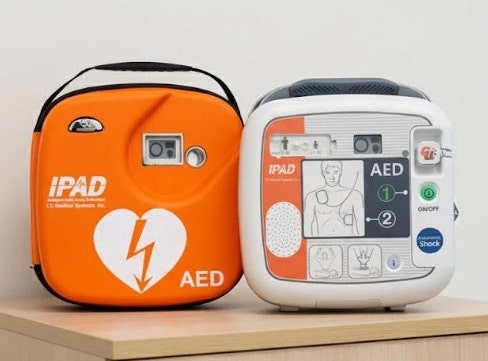


Date: 07 Nov 2025
In today’s world of increasing health awareness and risk, the question “Should homes and offices have AEDs?” is becoming ever more relevant. Sudden cardiac arrest (SCA) can strike without warning, and every minute counts.
The availability of a well-placed, ready-to-use automated external defibrillator (AED) can make the difference between life and death.
In this article we’ll explore what an AED is and how it works, who should consider having one (including homes with cardiac patients and workplaces/public spaces), the key features to check before buying, legal and training requirements, and finally some of the best AEDs available online today.
An automated external defibrillator (AED) is a portable electronic medical device designed to diagnose life-threatening cardiac arrhythmias (such as ventricular fibrillation or pulseless ventricular tachycardia) and deliver an electric shock if required, so as to re-establish an effective heart rhythm.
These devices are intended for use by lay-responders or non-medical personnel: they provide voice and/or visual instructions, analyse the heart rhythm, determine whether a shock is needed, and prompt the user accordingly.
When someone collapses with SCA, each minute without defibrillation reduces their chance of survival by about 10%. Thus, having an AED nearby, and knowing how to use it, can help bridge the gap between collapse and professional medical help that may take several minutes to arrive.
If a household includes someone with known heart disease, past cardiac arrest or arrhythmia, or other high-risk conditions (such as cardiomyopathy or serious coronary disease), the presence of an AED at home can provide peace of mind and timely intervention. Research indicates that most out-of-hospital cardiac arrests happen at home.
In such settings, an AED that is easy to access, user-friendly (with clear prompts), and regularly maintained can empower family members to act quickly — something that can radically alter the outcome.
Moreover, homes with elderly occupants, those living alone, or places where rapid EMS arrival is unlikely should strongly consider equipping themselves with an AED.
Offices, factories, schools, community centres, sports clubs and other public spaces are increasingly regarded as important locations for AED placement. In a workplace setting an AED assists with fulfilling a “duty of care” to employees, visitors and clients.
Many national guidelines recommend placing AEDs in areas of high foot traffic, where delays to professional help may occur, or where vulnerable populations gather. Having an AED onsite can reduce the time to first shock, thereby improving survival rates significantly.
When choosing a workplace, factors such as accessibility, signage, staff training, maintenance and legal compliance come into play (explored further below).
When selecting an AED for home or office use, it’s essential to ensure you pick a device that is reliable, suitable to the environment and easy to use. Here are some key features and considerations:
While legal requirements vary by country and region, several general principles apply:

Here are two strong models to consider — each from a reputable brand. (Please check with local/regional suppliers for availability in Kenya or East Africa.)
1. Philips HeartStart OnSite (or Home variant):
2. ZOLL AED Plus:
Note: These models are representative — when buying, always check for local supplier support, pads/batteries availability, warranty/service network in Kenya or your country.
Equipping a home or office with an AED is a proactive step towards emergency-preparedness and can put you ahead in the chain of survival. Whether you are a homeowner wanting to protect vulnerable family members or a workplace looking to provide a safer environment, selecting the right AED, placing it well, maintaining it and ensuring users are trained are all key.
With models like the Philips HeartStart OnSite and ZOLL AED Plus widely available online (and with reputable retailers offering packages), it is feasible to integrate this life-saving tool into your setting.
Q1: How quickly must an AED be used after a cardiac arrest?
A: The sooner, the better — every minute without defibrillation reduces survival by about 10%. Having an AED on-site cuts down delay until professional help arrives.
Q2: Can anyone use an AED?
A: Yes. AEDs are designed for lay-responders with clear instructions. However, basic CPR training is strongly recommended, and familiarity with the device improves confidence and effectiveness.
Q3: Do I need a doctor’s prescription to buy an AED for home use?
A: That depends on your country/regulation. In many places, AEDs for personal or workplace use can be purchased without prescription, but local laws vary. It’s best to check with local medical device regulations or import laws.
Q4: How often must the AED consumables (pads/battery) be replaced?
A: Typically, pads and batteries have expiry dates (e.g., 2-5 years) and should be replaced when expired. The device should self-test regularly — you should monitor the readiness indicator and replace consumables accordingly.
Q5: Is an AED enough, or do I also need to train staff/residents in CPR?
A: While an AED significantly increases survival chances, effective CPR before shock is essential. Training in CPR + using the AED is recommended to maximise benefit.